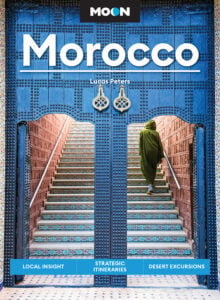An adventurous expedition to the majestic Sahara Desert begins with a trip back in time to ancient villages and towns that lie in the heart of Morocco. These villages and town contain authentic Berber castles and historic Foreign Legion outposts that now sit vacant. Roadways twist and turn, connecting each small village to the next. These roadways carry travelers from scenery of village life to the breathtaking Sahara Desert and back again.
In the not so distant past, traders gallivanted along the roadway trading their wares from Marrakech to the Sahara via camels. A journey to these trading (at the time) capitals began with a climb up the road leading out of Marrakech. Here, the traders would continue climbing up to the Atlas Mountains where evergreen and cedar forest undulated at an altitude of 7,400 feet. Travelers could see oncoming trading caravans, weather patterns and other towns from atop lookout points such as Col de Tichka.
Traveling down to the other side brought traders to villages such as Ouarzazate, Zagora, Erfound and Errachidia. Each of these villages brought an individual touch of charm and character to the Sahara Desert; and, visiting them today one feels the eternal touch of erstwhile years still lingering slowly by.
Nestled among the natural beauty of the Sahara Desert are an estimated 5 million palm trees. Walking, hiking or day trekking in the midst of these beauties consumes the mind, body and soul. Every corner brings a remarkable sight. One cannot escape the true majestic beauty that these palm trees bring to the Sahara Desert. These palm trees bring more to the desert than aesthetic appeal, however.
Local villages and towns such as in the Ziz Valley or Draa Valley make a substantial economic living off the dates produced from the palms each year. In addition to this, the palms stand tall enough to provide shading to crops and fruit trees. Underground, the roots of the palm trees work to prevent soil erosion from occurring because of fierce winds that rip through the Sahara Desert and surrounding valleys.
The contributions of palm trees do not stop there, nevertheless. Many villagers bring the palm trunks inside to function as ceiling beams in houses. Palm fronds are fashioned into brooms and are used to sweep floors and sidewalks. Other uses range from baskets and maps to buckets and clothelines.
Palm trees are used for more than structure and shade, though. Palm tree sap is also fashioned into wine from the palm tree base and is later distilled. Some believe palm tree fronds contain aphrodisiac elements. The palm trees in the Sahara Desert have a life span of approximately 150 years. They stand tall and proud among some of the most breathtaking natural scenery that the Sahara Desert and valleys that make this part of Morocco a must see for any Morocco traveler.
By Sam Mitchell








